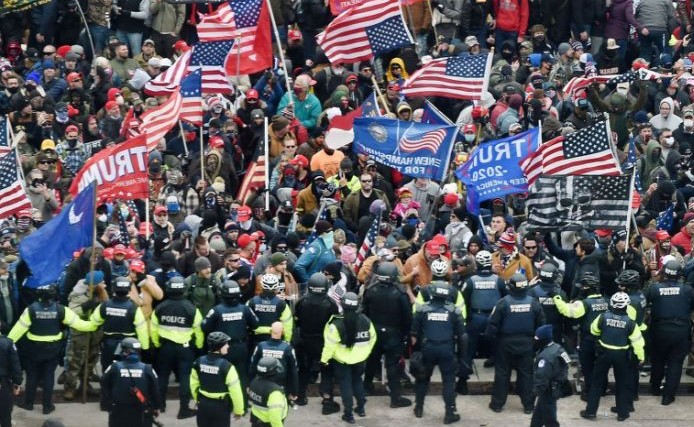In the violent, public insurrectionary attack on the U.S. Capitol Building on January 6, 2021, right-wing extremists seized a political opportunity to enact their violent agendas alongside a mob of QAnon conspirators, hyper-masculinist combatants; people agitated by COVID closures and gun control; ex (and maybe current) military and law enforcement; fervent Trump followers; evangelical Christians; and adherents of other adjacent right and far-right movements.
As far as we know, participants’ motives varied. Some thought they could keep Trump in office, some were venting rage about COVID restrictions and fear of gun control in a Biden administration. Virtually all were men, and the hyper-masculinist expressions of entitlement – to control politics, to take over space, to dominate the conversation - were loud and clear. And woven throughout was white supremacism, from the presence of visible, notorious white supremacist extremists to the coded insistence of the many that it is only the votes of whites that should matter in national elections.
What did they want to accomplish? Some wanted to stop a national election, which they nearly did. Others seem to be intent on assassinating politicians they saw as enemies. The most ideologically fluent white supremacist extremists among them likely saw this as an opportunity to accelerate social chaos and hasten race war, ideas fed by such neo-nazi tracts as James Mason’s Siege and William Pierce’s (pseudonym Andrew Macdonald) The Turner Diaries.
Remarkably and catastrophically, their disparate motives and agendas merged in a common spasm of violent action that was barely checked by a law enforcement and Capitol security force with members now under suspicion for complicity with the insurrectionists.
As I write this, we are just learning what happened in the lead up to Jan 6 and during the siege. Whether Republican congresspersons were implicated in the planning is alleged but not yet determined. The immediate future is no less clear, although there are multiple threats of widespread violent attacks against the national and all 50 state capitols, the Biden inauguration, and other places in the wake of what white supremacists are celebrating as a victorious display on January 6.
There are too many unknowns to predict the future with any confidence. The extent to which white supremacist extremists coordinated the violence on Jan 6 is just starting to be revealed. A hunt for those involved is underway and arrests are beginning. But whether this will dent the momentum of white supremacist extremism or simply create new martyrs to the white supremacist cause is unknown. Tech companies have exerted some immediate controls, expelling Trump and rooting out QAnon and other political disinformation. But whether tech companies are committed to sustainable policies that will prevent them from becoming platforms for accelerating violent subcultures in the future is unclear. What will happen with QAnon and adjacent conspiracy cultures opposed to COVID closures and vaccinations when Trump leaves office & has less ability to reach followers is also up in the air. We know that conspiracy-geared movements can implode quickly when they lose their leaders. But they also can morph into new forms, absorbing other conspiratorial ideas & directions.
What should we be watching in the aftermath of Jan 6? Questions that are likely to be key to what will happen in the U.S. in the near future include:
- How many white supremacist extremists are arrested for Jan 6 or subsequent violent action? Of these, how many are successfully prosecuted and sentenced? Are civil suits filed by victims of violence against multiple white supremacists, and do these create conflict among white supremacists?
- Does explicit violent talk continue to escalate after Biden takes office, and how do its targets change? Is there an uptick or downturn in detailed discussions of using weapons of mass violence?
- What is the interplay between online and in-person white supremacist extremism after Jan 20? Do groups such as the Proud Boys, Boogaloo Bois, Three Percenters, etc start to submerge and hide in on-line spaces?
- Do current online efforts to elevate those who died in the Jan 6 violence as martyrs to the cause continue to gain traction or does this fizzle? Do additional white supremacist extremists or allied participants die and become martyrs?
- How does the shake-up of white supremacist-friendly tech platforms play out? To what extent do different strands of extremists gravitate to different platforms/channels, versus sharing platforms/channels in which their messages can flow across ideological strands?
- Does QAnon undergo a crisis of faith when Trump leaves office, and what happens to its adherents?
.jpg)




